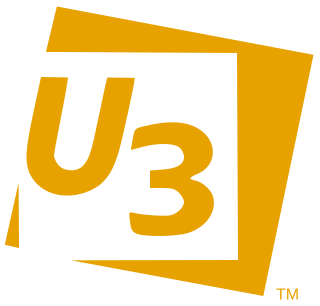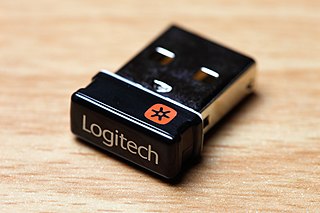
In computer networking, a thin client is a simple (low-performance) computer that has been optimized for establishing a remote connection with a server-based computing environment. They are sometimes known as network computers, or in their simplest form as zero clients. The server does most of the work, which can include launching software programs, performing calculations, and storing data. This contrasts with a rich client or a conventional personal computer; the former is also intended for working in a client–server model but has significant local processing power, while the latter aims to perform its function mostly locally.
A whitelist or allowlist is a list or register of entities that are being provided a particular privilege, service, mobility, access or recognition. Entities on the list will be accepted, approved and/or recognized. Whitelisting is the reverse of blacklisting, the practice of identifying entities that are denied, unrecognised, or ostracised.

A Flash drive is a data storage device that includes flash memory with an integrated USB interface. A typical USB drive is removable, rewritable, and smaller than an optical disc, and usually weighs less than 30 g (1 oz). Since first offered for sale in late 2000, the storage capacities of USB drives range from 8 to 256 gigabytes (GB), 512 GB and 1 terabyte (TB). As of 2023, 2 TB flash drives were the largest currently in production. Some allow up to 100,000 write/erase cycles, depending on the exact type of memory chip used, and are thought to physically last between 10 and 100 years under normal circumstances.

A security token is a peripheral device used to gain access to an electronically restricted resource. The token is used in addition to, or in place of, a password. Examples of security tokens include wireless keycards used to open locked doors, a banking token used as a digital authenticator for signing in to online banking, or signing a transaction such as a wire transfer.

In computing, a docking station or port replicator (hub) or dock provides a simplified way to plug-in a mobile device, such as connect common peripherals to a laptop, or charge a smartphone. Because a wide range of dockable devices—from mobile phones to wireless mouse—have different connectors, power signaling, and uses, docks are unstandardized and are therefore often designed for a specific type of device.

U3 was a joint venture between SanDisk and M-Systems, producing a proprietary method of launching Windows software from special USB flash drives. Flash drives adhering to the U3 specification are termed "U3 smart drives". U3 smart drives come preinstalled with the U3 Launchpad. Applications that comply with U3 specifications are allowed to write files or registry information to the host computer, but they must remove this information when the flash drive is ejected. Customizations and settings are instead stored with the application on the flash drive.
Anti–computer forensics or counter-forensics are techniques used to obstruct forensic analysis.

Intel Active Management Technology (AMT) is hardware and firmware for remote out-of-band management of select business computers, running on the Intel Management Engine, a microprocessor subsystem not exposed to the user, intended for monitoring, maintenance, updating, and repairing systems. Out-of-band (OOB) or hardware-based management is different from software-based management and software management agents.

In computing, a blacklist, disallowlist, blocklist, or denylist is a basic access control mechanism that allows through all elements, except those explicitly mentioned. Those items on the list are denied access. The opposite is a whitelist, allowlist, or passlist, in which only items on the list are let through whatever gate is being used. A greylist contains items that are temporarily blocked until an additional step is performed.
The Elonex ONEt is a netbook computer marketed to the education sector in the UK by Elonex. Inspired by the OLPC initiative, the low cost of the ONE, the ONEt and similar devices, made this subnotebook seem an attractive proposition for educators seeking to provide every child with a highly functional laptop computer. However initial ONEt trials by educators claimed that the lack of security, specifically the absence of any password protection at start-up, put personal information at risk, making it unsuitable for use in a school environment. It was released in September 2008, on sale to the general public, marketed as an upgrade to the ONE. It has Wi-Fi connectivity, a solid-state hard drive, three USB ports and an SD card slot.
Secure USB flash drives protect the data stored on them from access by unauthorized users. USB flash drive products have been on the market since 2000, and their use is increasing exponentially. As both consumers and businesses have increased demand for these drives, manufacturers are producing faster devices with greater data storage capacities.
Check Point GO is a USB drive that combines an encrypted USB flash drive with virtualization, VPN and computer security technologies to turn a PC into a secure corporate desktop. By plugging Check Point GO into the USB port of a Microsoft Windows OS-based PC or laptop, users can launch a secure virtual workspace that is segregated from the host PC. This allows users to securely access company files and applications from any remote location, including insecure host environments such as a hotel business center or Internet café.

The Logitech Unifying Receiver is a small dedicated USB wireless receiver, based on the nRF24L-family of RF devices, that allows up to six compatible Logitech human interface devices to be linked to the same computer using 2.4 GHz band radio communication. Receivers that are bundled with a Logitech product are paired with the device at the factory. When purchasing a replacement receiver or connecting multiple devices to one receiver, pairing requires the free-of-charge Logitech Unifying software, available for Microsoft Windows and Mac OS X. On Linux the Solaar software can be used to adjust the configurations. Although not compatible with Bluetooth, devices pair to Unifying Receivers in a similar way. Peripherals remain paired, and can then be used on systems not supporting the software. Logitech receivers compatible with the Unifying protocol can be identified by the orange Unifying logo, which distinguishes them from Logitech Nano receivers of similar appearance, which pair in a similar manner but only with a single device, without using the Unifying protocol.
Absolute Home & Office is a proprietary laptop theft recovery software. The persistent security features are built into the firmware of devices. Absolute Home & Office has services of an investigations and recovery team who partners with law enforcement agencies to return laptops to their owners. Absolute Software licensed the name LoJack from the vehicle recovery service LoJack in 2005.
The following outline is provided as an overview of and topical guide to computer security:

Librem is a line of computers manufactured by Purism, SPC featuring free (libre) software. The laptop line is designed to protect privacy and freedom by providing no non-free (proprietary) software in the operating system or kernel, avoiding the Intel Active Management Technology, and gradually freeing and securing firmware. Librem laptops feature hardware kill switches for the microphone, webcam, Bluetooth and Wi-Fi.
In the computing world, where software frameworks make life of developer easier, there are problems associated with it which the developer does not intend. Software frameworks use object-relational mapping (ORM) tool or active record pattern for converting data of different types and if the software framework does not have a strong mechanism to protect the fields of a class, then it becomes easily exploitable by the attackers. These frameworks allow developers to bind parameters with HTTP and manipulate the data externally. The HTTP request that is generated carries the parameters that is used to create or manipulate objects in the application program.

Purism, SPC is an American computer technology corporation based in San Francisco, California and registered in the state of Washington.

The Pinebook is a low-cost notebook developed by Hong Kong-based computer manufacturer Pine64. The Pinebook was announced in November 2016 and production started in April 2017. It is based on the platform of Pine64's existing Pine A64 single board computer, costing US$89 or US$99 for the 11.6" and 14" model respectively. Its appearance resembles the MacBook Air. The Pinebook is sold "at-cost" by Pine64 as a community service.

BusKill is an open-source hardware and software project that designs computer kill cords to protect the confidentiality of the system's data from physical theft. The hardware designs are licensed CC BY-SA and the software is licensed GPLv3. BusKill cables are available commercially from the official website or through authorized distributors.












